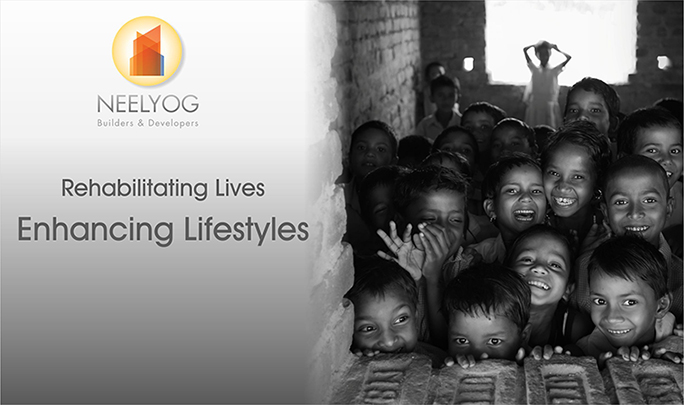Rushi Mehta (MBA 2006) on his time as an ULMS student and his involvement in slum redevelopment in Mumbai with Neelyog Construction
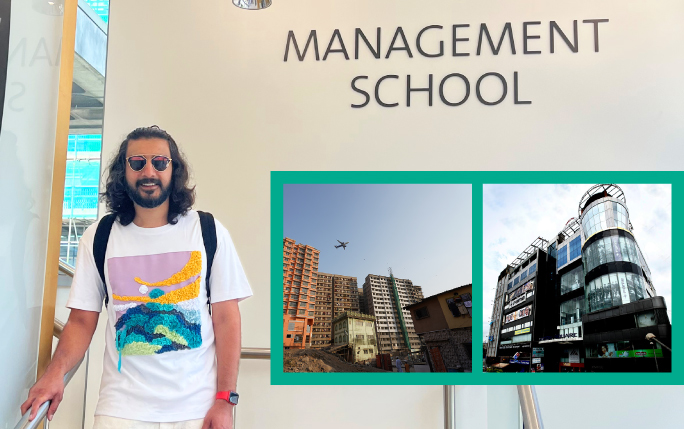
Rushi visited campus on a trip to the UK in the summer and it was a pleasure to show him, his wife and their two sons around. On his return to Mumbai, we asked Rushi to share some reflections on his time as an MBA student and his work with Neelyog Construction, where he is a Director.
My time in Liverpool helped me directly/indirectly in my business, which goes beyond the books and the structured learning
I come from a family of highly educated people and it was always my dream to get some exposure abroad to get a different learning experience before getting into my family business. I did an MBA in Business Finance and Management with ULMS and that one year was a life-changing experience for me which taught me so many life skills, gave me an understanding and appreciation of different cultures, taught me patience and acceptance, broadened my thinking and gave me experience which cannot be expressed in words. But all that aside, it gave me a lifetime of memories and lifelong friends spread across the length and breadth of the globe.
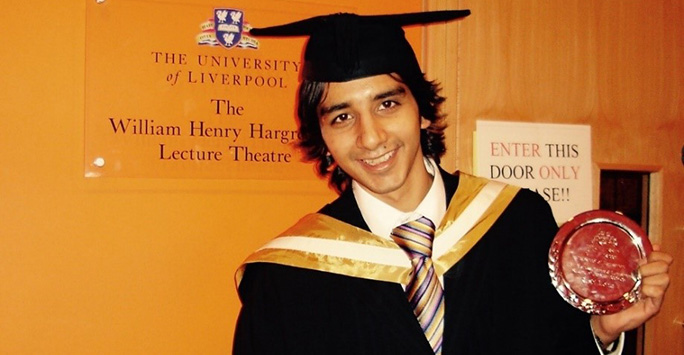
Rushi graduating in 2006
Growing up I was always in a protected environment. My friends, social circle and all my interactions were with people of similar standing and social strata. When I came to Liverpool, I met people from all walks of life and I quickly realised that people have layers and shades to them which need to be understood and appreciated. The stint in Liverpool helped me to understand people better. I met people from all cultures, which helped me understand different ways of life and how one needs to have an acceptance and tolerance for different people and their way of living. I shared my house with an Indian student who before coming to Liverpool had never been to a town before, and students from America, Ireland, China and Turkey. Our differences aside, we had a whale of a time over the year that we lived together.
A small memory of my learning experience comes to mind. I was a Rank Holder Chartered Accountant in India and had a great proficiency with accounts and numbers. During my time in Liverpool, I helped many friends with various assignments and exam preparations. When the results of the first marked assignment filtered in I was in for a rude shock as I had scored less than some of my friends who had relatively negligible accounting/finance experience and background. Distraught, I sought an appointment with Dr David Brookfield to air my feelings. After patiently listening to my tirade, David told me: “Rushi I can only help you out if you hear me with an open mind and if you think that you can still learn something here.” He explained that he was aware I was proficient in numbers which was evident from my paper but the University of Liverpool and the system of education demanded much more than just numbers from its students. It demanded thorough research, critiquing existing research, finding parallels etc. He set me upon a path of a new way of learning and opened my eyes to the fact that knowledge is limitless and the minute one thinks that they know it all, it strangulates the growth in that individual. I took the principles shared by him that day to heart and embraced the new system rather than challenging it as I was doing up until then. With the right guidance and attitude, I finished my MBA programme top of my class and was awarded “Student of the Year.”
This was only one of countless experiences during my time in Liverpool which helped shape my personality and prepared me for my entry into the family business. When I visited Liverpool after a break of 15 years with my family, the city had completely transformed and I kept looking for familiar corners and shops and places which brought back a feeling of nostalgia for me. Like me, the city has progressed in the time since I left its shores and revisiting it after 15 years was a crazy experience for me, one which I got to share with my wife and my young boys. This city and University will always hold a special place in my heart as it welcomed me with open arms and gave wings to my dreams.
The issue of slums in my city Mumbai
Mumbai, which is surrounded by water on three sides, has waged a constant battle since the colonial era to find space to expand. Adding to the pressure is the fact that growing employment opportunities in the city have led to a continuous influx of migrants from other areas of India. The shortage of affordable housing and a steady increase in real estate prices in the city has made formal housing unaffordable for most of these migrants. This has led to proliferation of slum pockets across the city. Mumbai’s slums occupy 12% of its total geographic area and up to a quarter of the available construction area in the city.
- An estimated 6.5 million people, around 55% of Mumbai’s total population, live in slums. Most of the slum tenements do not have access to proper sanitation and clean water supply. The following facts demonstrate the sub-standard living conditions of people currently residing in slums in the city.
- Private toilets are unheard of in slums. Further, 78% of community toilets lack proper water supply and 58% have no electricity.
- On average, there is only one tap that is to be shared by 52 slum dwellers. This is evidence of lack of access to safe drinking water.
- Many slums do not have access to electricity supply. Some slum pockets in Deonar, Kurla, Khar and Santacruz are completely un-electrified. In others, such as, Kandivali (28.47%), Borivali (44.98%), Bhandup (22.57%) substantial portion of the population does not have access to the electricity.
- Slums in the city also do not have proper drainage system. This is not only unhygienic but also provides ground for breeding of mosquitoes and other disease spreading vectors.
There is always a security issues as their slum structure is not concrete. The slums have common toilets which leads to issues for female members of the house who have to walk up to the public toilets, sometimes in the middle of the night. The slums are overcrowded and unstructured which means that they bear the brunt of all adverse events both natural like fire, earthquakes etc and man-made like riots, drug culture, gangs, lawlessness etc.
The Government’s approaches to slum redevelopment
Through the years, the Government of Maharashtra has tried various initiatives to deal with the slum problem of Mumbai. In the 1950s and 1960s, the government decided to clear slums and rehouse slum dwellers in subsidised rental housing. This approach did not succeed for lack of resources. After realising that slum eradication and removal was not the solution, in 1970s and 1980s, through various acts and programmes, the government tried slum improvement instead of clearance which meant providing basic services like water, toilets, electricity, pathways, streetlights, primary health care and education to slum dwellers. However, the scale of programmes remained limited and did not create much impact.
In 1995, the Government set up the Afzalpurkar committee which recommended rehabilitation of slums through redevelopment and trying to bring the slum dwellers into the main stream society and social fabric of the city. The focal mechanism for achieving this was using land as a resource for attracting private partnership by providing FSI (floor space index) to private builders in 1:1 ratio i.e. 1 sq. meter of free sale component for every sq. meter of Rehab Component providing free housing for poor to shift the burden of slum rehabilitation to private players.
Accordingly, the Maharashtra Slum Areas (Improvement, Clearance and Redevelopment) Act, 1971 (“Slum Act”) was enacted in 1971 inter alia for the purpose of improvement, clearance and redevelopment of slum areas in the State of Maharashtra.
Concept of FSI (floor space index) and granting incentive FSI to private developers to shift the burden of rehabilitation of slums
An estimated 50 lac (5 million) houses are required to house the people living in slums and the cost of construction of one tenement is roughly 5 lacs which means that the Government of Maharashtra would require an outlay of Rs 2.5 lac crore to construct houses for everyone which is excluding the cost of transit rent, administration costs and so on. It is clear that the Government was in no position to make such a commitment and hence it came up with a scheme which incentivised private developers to get involved in the process of redevelopment and rehabilitation of slums.
Mumbai boasts of one of the most expensive property markets in the world, partly due to the fact land is a very scarce commodity. Add to this the fact that the Mumbai’s international/domestic airports are in the heart of the city which puts a cap on vertical construction on certain parts close to the airport.
To understand how the developers were incentivised, we should first try to understand the concept of FSI. Floor space index is basically the built up area of all floors (except certain non-habitable areas like parking, lifts, stairwells, STPs, Underground tanks etc) divided by the plot area. In the city the inherent FSI for construction is 1 which means that on a plot of 1000 sq.mtrs, one can construct up to 1 FSI which is 1000 sq.mtrs which could be vertically spread over such number of floors after leaving the requisite open spaces on all sides as per the regulations and fire norms. There are various incentive schemes wherein Developer can purchase more FSI by paying premium to the government taking the FSI up to 3 or even 4.
Slum redevelopment schemes are one such incentive scheme wherein the Developer is made to provide free houses for all slum dwellers on the plot or the minimum density of 650 per hectare, whichever is more. This means that if on a plot of 10000 sq.mtrs if there are only 500 slum structures, even then developer is made to construct 650 free houses wherein 500 are given away free to the slum dwellers and the remaining 150 are handed over to the government which uses the said houses for removing slum structures where in-situ rehabilitation is not possible (for example road widening, airport area encroachment clearance, widening of drains etc).
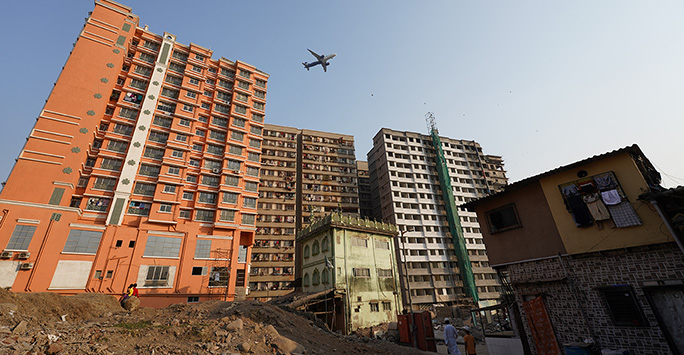
Slum redevelopment in a nutshell: the sale building, the slum structures, the free houses and the religious structures
Neelyog Construction – our experiences and challenges
Any time you are changing an established way of life, there is going to be an inertia. Sometimes it’s pure greed, sometimes reluctance due to uncertainty and sometimes just lack of trust. Due to varied reasons the process of rehabilitation of slums hasn’t always been easy. Add to that the fact that the slum dwellers are a political vote bank and there is a huge amount of political intervention at every level. There are also multitude of eligibility issues facing families.
Due to the above (and many more) issues, removing the slum structures for carrying out construction becomes a herculean task. The Judicial system is also burdened with countless complaints/cases in relation to slum rehabilitation schemes. Slum schemes are usually done in a phase wise manner wherein pockets are made empty by clearing a slum pocket, then constructing a building thereon to accommodate the people who are out on transit rent and also people from another slum pocket thus making it vacant for construction and so on. In phase wise development the existing infrastructure of the remaining slum structures is to be maintained which adds numerous constraints to development.
Our projects are funded by three main sources:
- internal/self-funding
- bank financing
- revenue generated from sale of flats/offices etc constructed in our sale component. For every sq.ft of free homes we get an equivalent area which we can construct as part of our sale component which we can sell in the open market. Hence the cost of building free homes and free sale component buildings has to be recouped from sale of houses/offices in our free sale component
In our business of slum rehabilitation, no one can be taken at face value. Most people have a hidden agenda which you need to decipher. Also, when a slum dweller hands over the structure to you for redevelopment, they are literally handing over their only physical belonging/possession to you and they will only do it if you can get down to their level, understand their problems and communicate to them in a language that they understand so that a level of trust and bond is created which allows them to part with the structure. Hence my experiences at Liverpool were invaluable, making me a better listener and a more open person.
All in all, redevelopment and rehabilitation of slums is not easy but I guess someone has to step up and do it. Neelyog Construction has been engaged in the slum rehabilitation schemes for the past three decades and in the process, we have constructed around 7,000 free houses, thereby rehabilitating around 50,000 Individuals and provided them with concrete self-contained homes which become the foundation to their development and success.
As part of the slum redevelopment schemes we have freed up large tracts of land and handed them over to the Government for expansion of railway lines, construction of new roads which until then just existed on paper, cleared up land reserved for play grounds. We have also constructed parking lots and drama theatres and handed over the same free of cost to the government (as the plots which we were developing and which were encroached with slums were reserved for parking lots and theatres respectively). We have also constructed countless religious structures like Mandirs, Masjids, Jain temples for people of all faiths as part of the rehabilitation and redevelopment process. We have constructed the first multiplex theatre in a slum redevelopment scheme wherein we used the sale component eligibility to construct a commercial complex which had retail shops, offices, restaurants, banquet halls and four screen multiplex theatre.
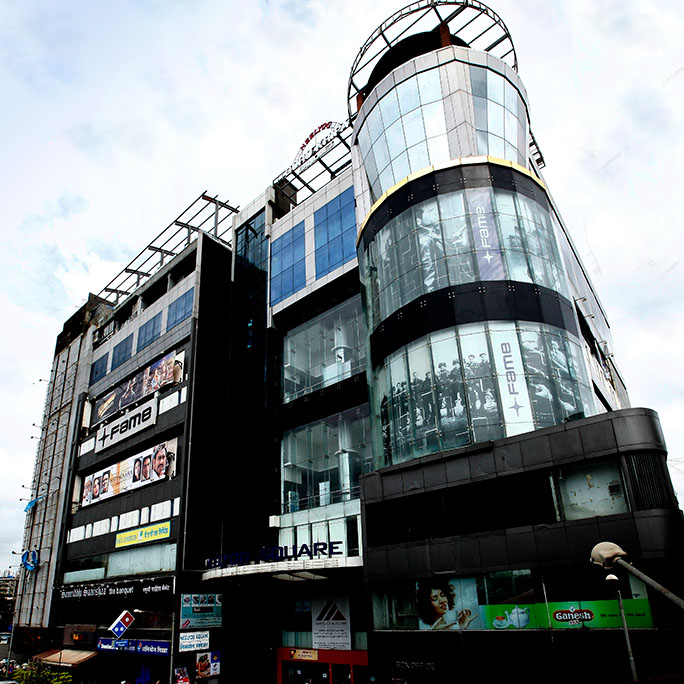
The first multiplex in a slum redevelopment scheme
Our company was founded by my father Mr Yogesh Mehta and its name is derived from an amalgamation of my father’s and mother’s names, my mother’s name being Neela. Like scores of people, my father had gone to Mumbai with just a dream in his heart and like countless people, the city of Mumbai embraced him with open arms and gave wings to his dreams. Having faced the problem of housing first hand, it was his vision to create a Slum Free Mumbai which had housing for all and hence at the first opportunity he dived into the business of Slum rehabilitation. Our company motto is “Rehabilitating Lives and Enhancing Lifestyles” and it is a simple and self-explanatory philosophy which forms the bedrock of our endeavours.
The process of rehabilitation of slums is difficult, stressful, cumbersome and risky all at the same time but the feeling you get when you see a slum family receiving the keys to their very own concrete house and that too free of cost, is worth all the trials and tribulations. The problems which the slum dwellers go through due to lack of housing are just unimaginable.
The COVID-19 pandemic has magnified the need for rapid rehabilitation and redevelopment of slum pockets. Then there is social stigma attached to being a slum resident which creates a problem for social development of the community. The idea of slum rehabilitation is not only provision of a house but an attempt to bring a large section of the city into the mainstream and integrating them into the social fabric of the city. Having a roof over one’s head is just the foundation and stability required for its inhabitants to pursue their dreams which leads to the overall development of the city and the country at large.
